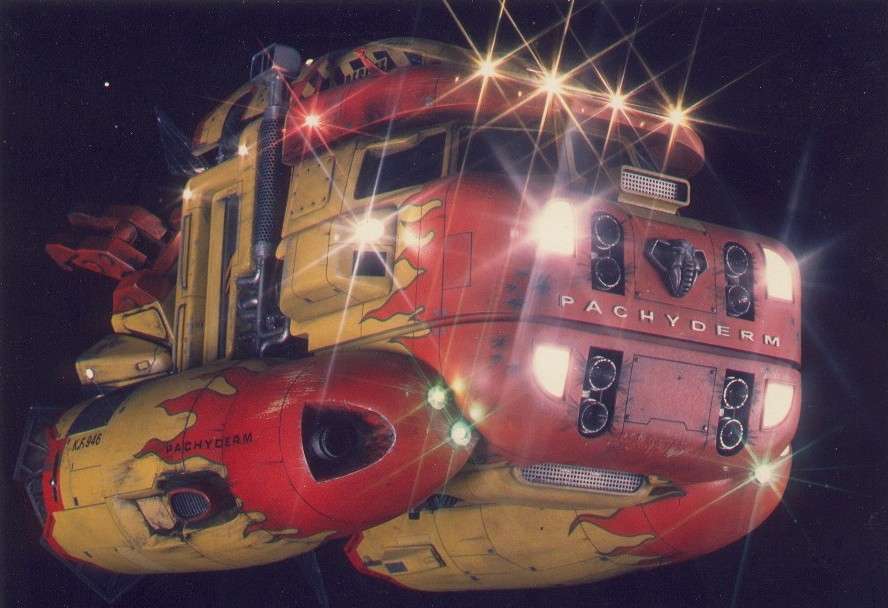Asteroid the size of a small truck buzzes Earth: NASA
Source: Reuters
An asteroid the size of a small truck zoomed past Earth four times closer than the moon on Saturday, the latest in a parade of visiting celestial objects that has raised awareness of potentially hazardous impacts on the planet.
NASA said Asteroid 2013 LR6 was discovered about a day before its closest approach to Earth, which occurred at 12:42 a.m. EDT (0442 GMT on Saturday) about 65,000 miles over the Southern Ocean, south of Tasmania, Australia.
The 30-foot-wide (10-metre-wide) asteroid posed no threat.
A week ago, the comparatively huge 1.7-mile-wide (2.7-km-wide) asteroid QE2, complete with its own moon in tow, passed 3.6 million miles (5.8 million km) from Earth.
Read more: http://www.reuters.com/article/2013/06/08/us-space-asteroid-idUSBRE94U12G20130608
zbdent
(35,392 posts)Berlum
(7,044 posts)
In_The_Wind
(72,300 posts)iamthebandfanman
(8,127 posts)and we are just now getting the ability to see all of them or are there just more occurrences happening these days?
longship
(40,416 posts)We see more of them because we can see more of them. They've always been around, so to speak.
But, the data on the Chixulub asteroid wiping out the dinos is pretty definitive and has raised consciousness at just the time when we do have the instruments to find these things, and the technology to prevent a disaster.
Wasn't it Larry Niven who said something like, "the reason the dinosaurs went extinct is that they didn't have a space program."
I don't think many people put much faith in the many minority theories these days. Like this one, for instance:

gvstn
(2,805 posts)Didn't we put some "satellites" around the sun so that we could see these objects coming with a bit more notice? I thought that happened a few years ago so that we could see "behind" the sun.
longship
(40,416 posts)But the B612 Foundation has a lot of information on its Web site. They have a lot of very smart people who are looking very closely at what we can do.
Indeed, asteroids are very difficult to find. For one, they tend to be very dark, low albedo. But as you pointed out, a telescope place inside Earth orbit looking out would have an advantage. As far as I know, B612 has exactly this on their agenda.
Apollo 9 Astronaut Rusty Schweickart is heavily involved in B612 and these matters.
Also, you might want to take in Phil Plait's TEDx talk on this topic (he's the Bad Astronomer):
Capt.Rocky300
(1,005 posts)I'm getting back into astronomy and observing after a long hiatus due to other life priorities. This looks like a great website.
I found this which is what I was thinking about: http://stereo.gsfc.nasa.gov/360blog/
It apparently only observes the sun from two different angles and is not a telescope attempting to observe the area behind the sun. Perhaps when it was originally announced bloggers speculated on other possibilities using similar trajectories? Well, at least I now know that we don't have anything out there for an early warning system for objects coming from behind the sun. I had been wondering how so many could have gotten past such a device as have these past several months but just figured because of the dimness of the objects that was to be expected. ¯\_( ツ )_/¯
longship
(40,416 posts)It is not asteroids coming from behind the sun that are the big problem. It is those whose orbits make their approach to earth from the direction of the sun in the sky. The latter are near impossible to see due to the fact that sun's glare overwhelms the detector. An object like this could hit the Earth without any warning. And they are not necessarily behind the sun, in fact, normally not.
To see these near Earth asteroids we place a telescope in an orbit inside Earth's looking out. Then, the telescope can see the asteroid because the viewing field wouldn't be washed out by the sun's glare, which is the problem in the first place.
The B612 Foundation is trying to get precisely this sort of telescope built and launched. It wouldn't even have to be a big Hubble-sized scope. It would just have to have a good detector (digital camera).
Possibly a good place for such a scope would be the L1 Sun-Earth Lagrangian point.

I hope this helps. (Edited for more clarity.)
muriel_volestrangler
(101,361 posts)At any one moment, it's blinded in exactly the same direction - the direction of the Sun. The only places it would be able to look, that we can't on Earth, is the (relatively) small distance between L1 and Earth - about 1.5 million kilometres (one hundredth of the distance to the Sun). So it might give us a day or 2 of warning, at best, but probably not that - you might try evacuating an area, I suppose, but it wouldn't be pretty.
The B612 Foundation you mention proposes an orbit around the Sun with a period of 7 months:
http://b612foundation.org/sentinel-mission/the-mission/
http://b612foundation.org/sentinelmission/
which crosses Venus' orbit. That allows them to look out at the whole width between Venus and Earth, over time.
longship
(40,416 posts)Mainly stability, it is always between the sun and the Earth. Keeping something there uses little energy.
But, you're correct, it is too close to Terra.
I stand corrected on that part. It was just a quick thought on my part, without really thinking deeply about it.
Thank you for the correction.
eggplant
(3,913 posts)...Lagrange points are our space-based landfills. Everything without sufficient propulsion (that doesn't fall into our atmosphere) ends up heading towards an L-point. Seems like a dangerous place to park something valuable.
Posteritatis
(18,807 posts)To give you an idea, the main asteroid belt has a couple of million asteroids about a kilometer wide or larger, and probably several orders of magnitude more that are significantly smaller. That doesn't include asteroids in other orbits, like the one in this article, of which there are probably tens of millions more.
The solar system's pretty crowded in number-of-things terms; we're getting a lot better at noticing them but there's only so many eyes looking out there, most of which can't detect asteroids in realtime, and which can't see all the sky in depth at once.
Fumesucker
(45,851 posts)You don't really need to go into space to look for asteroids, you just have to cover a lot of sky to a deep magnitude and do it often, at the moment that's easier to do on the ground.
http://www.lsst.org/lsst/
Plans for sharing the data from LSST with the public are as ambitious as the telescope itself. Anyone with a computer will be able to fly through the Universe, zooming past objects a hundred million times fainter than can be observed with the unaided eye. The LSST project will provide analysis tools to enable both students and the public to participate in the process of scientific discovery. We invite you to learn more about the science of LSST.

Politicalboi
(15,189 posts)Bedrock, Twist Twist. ![]()
4bucksagallon
(975 posts)but how can something be four times closer than the moon? Shouldn't that be one quarter the distance of the moon? Semantics, or rather differences in language? Or as I say I am getting old.
longship
(40,416 posts)Nye Bevan
(25,406 posts)So if something is 100 miles away, its "closeness" is 0.01 miles^-1.
Posteritatis
(18,807 posts)yellowcanine
(35,701 posts)Why not say the actual miles, and then note that this is approximately 1/4 the distance to the moon? Or better yet, employ the sports analogy and tell us how many football field lengths away the asteroid was?
yellowcanine
(35,701 posts)3/4 ton, 1 ton van???????? I hate it when crucial details are left out.
muriel_volestrangler
(101,361 posts)Last edited Sat Jun 8, 2013, 03:42 PM - Edit history (1)
radius = 5m; 4*pi*r*r*r/3 is roughly 500 cubic metres; if you assume 2 tonnes/cubic metre (the same as 2g/cm3), you're at 1000 tonnes - or tons, roughly.
It was approaching the neighborhood of Earth at about 9.5km/s; that gave it a kinetic energy of about 45 terajoules - a little under the 67 TJ of the Hiroshima bomb (but if it picked up speed due to earth's gravity, and I think it would have, then it probably would have had a bit more, if it had hit). But it wouldn't have been a planet-wide changing collision.
yellowcanine
(35,701 posts)A tractor trailer grosses a maximum of 40 tons fully loaded in most U.S. jurisdictions, so I don't see where the "small truck" comes from.
muriel_volestrangler
(101,361 posts)and decided a small truck. But, yeah, trucks aren't 10m in all 3 dimensions. "The size of a medium-sized house" might have been better.
yellowcanine
(35,701 posts)squatty glass when in reality the two glasses hold the same volume. One might say this is thinking in one dimension.
MillennialDem
(2,367 posts)yellowcanine
(35,701 posts)And I expect better of NASA than to give a one dimensional measurement of a space object.
MillennialDem
(2,367 posts)accurate idea I saw, but meh.
Demeter
(85,373 posts)Right in DC. Where the NSA, CIA, WH and Congress are destroying America.
Then perhaps Wall St and its subdivisions.
Then perhaps we could rebuild that shining city on the hill which Reagan tore down, and his successors have bombed into submission.
liberal N proud
(60,346 posts)

It's all relative!
yellowcanine
(35,701 posts)That is a terrible mutilation of a classic VW bus, by the way.